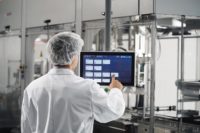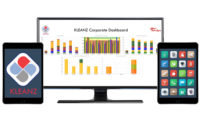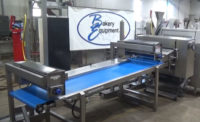Lubrication is critical to equipment functionality and longevity. And in food production environments like snack and bakery facilities, it’s also imperative that lubricants do not contaminate products and pose a health hazard.
Current best practices call for proper storage and use, employee training and documentation. On a positive note, advances have been made to improve the performance of lubricants in these demanding environments.
Identifying parameters
The use of food-grade lubricants should be based on risk assessment for potential contamination of products. In those cases, a food-grade lubricant should be considered, along with deflectors or catch pans to lessen contamination risks.
“We see two types of lubricants used in these at-risk locations,” says Bill Steadman, manager, food safety services, North America, AIB International, Manhattan, KS. “The first is H1 lubricants, which are food-grade lubricants used in food processing environments where there is the possibility of incidental food contact. The second is H2 lubricants, which are food-grade lubricants used on equipment and machine parts in locations where there is no possibility of contact. The ratings are currently maintained by NSF International and can be verified against their White Book database. ISO standard 21469 is also used.” (For more information, see the NSF “White Book Nonfood Compounds Listing Directory” at https://info.nsf.org/USDA/psnclistings.asp.)
Recent improvements have been made regarding heat-resistant lubrication. Many bakeries now use food-grade lubrication on drive chains that are located near ovens.
Key components that require specialized lubrication in the bakery and snack industry include transport chains, because the environment can be challenging due to high temperatures and humidity. “Improper chain lubrication can lead to residue build-up, wear and eventually the loss of articulation in these chains,” says Marius Czech, food market manager, Klüber Lubrication NA LP, Londonderry, NH.
Market options
Lubricants utilized in the bakery and snack industry should be food-grade certified by NSF or ISO. Proper labeling of all lubricant containers, points and dispensers is required. A detailed plan should be followed by employees for transportation of both lubricants and applicators. “The minimum amount should be applied because excess lubricant can contaminate food. Due to technical advances, some lubricants are becoming more oxidative-resistant, hydrolytic-resistant and thermal-resistant,” says Ken Dreyer, sales manager, Madison Chemical Co. Inc., Madison, IN.
New synthetic lubricants based on perfluoropolyether (PFPE) and polyolester (POE) fluids deliver outstanding performance in high-temperature baking applications, and are NSF/H1-registered food grade, according to Jim Girard, executive vice president/CMO, Lubriplate Lubricants Co., Newark, NJ. His company offers the Lubriplate HTCL FG-220, a 100 percent synthetic, POE-based fluid lubricant that is specifically designed for use on oven chains in food manufacturing operations where incidental food contact is a possibility.
“The combination of an ashless additive system and the synthetic ester base provides protection against wear, rust, oxidation and corrosion. It eliminates carbon build-up on chains and helps maintain a clean lubricated surface. Free of volatile organic compounds, the product’s film strength reduces oil consumption and smoke. Also, high auto-ignition temperatures reduce the risk of oven fires,” Girard explains.
Can dry cleaning methods be used to reduce moisture in bakery and snack plants? Steadman says that dry cleaning is used more often after mix-and-make process steps, as these areas typically use wet ingredients. If it’s a dry processing type, usually a dry cleaning method is used. “Dry cleaning methods should incorporate brushes and vacuums. API recommends only using compressed air for areas that are extremely hard to reach. When necessary, a reduced PSI should be used and only during downtime.”
Interflon USA, Swanton, VT, has formulated lubricants with MicPol technology, which resists water, instead of attempting to eliminate water from the equation. In some industries, it’s not possible to remove water from the cleaning process, because the process relies on high-pressure spray of hot water and sanitation chemicals, according to William Kowalski, director of online operations.
“In bakery and snack operations, humidity will always be present because of the use of water as an ingredient. Rather than expect producers to remove water from their cleaning procedures, which in many cases is an impractical and inconvenient expectation, we have addressed the challenge by developing MicPol technology, which prevents any water from making contact with surfaces,” Kowalski explains.
Sanitation priorities
What do operators need to do to keep their processing environments as sanitary as possible? From a lubrication standpoint, the correct handling and use of the correct lubricant on each application is important. “Operators should avoid lubricant leaking on their gearboxes because oil is not compatible with the gearbox seal. They don’t want to have carry-over of grease because of improper usage, or to have the grease flow out of the bearing due to the wrong National Lubricating Grease Institute class being used,” Czech advises.
To ensure proper application, it is important to label or engrave lubrication points. “Interflon USA recommends that lubrication points be clearly marked in order to ensure that none get missed during lubrication,” Kowalski says. “Missing even one point can result in a breakdown. The same is true if the incorrect lubricant is used on an application. Lubricants for high-temperature applications do not mix well with other lubricants.”
Kowalski says that the use of color-coding is the best solution. “Our products are available in color-coded tubes that can be matched to colored stickers, so there is no chance of using the wrong lubricant. We also recommend the use of lubrication maintenance software such as LUBE-IT, which records every interaction with every lube point.”
Looking ahead, Kowalski predicts that manufacturing plants of the near future will begin using radio-frequency identification (RFID) or artificial intelligence (AI) to identify all maintenance points and lubricants used, so that the possibility of using the incorrect lubricant is removed and a complete maintenance record exists. “With all the data generated by the use of such systems, it’s possible that algorithms will be used to predict where breakdowns are most likely to occur and to direct predictive maintenance to that area.”





